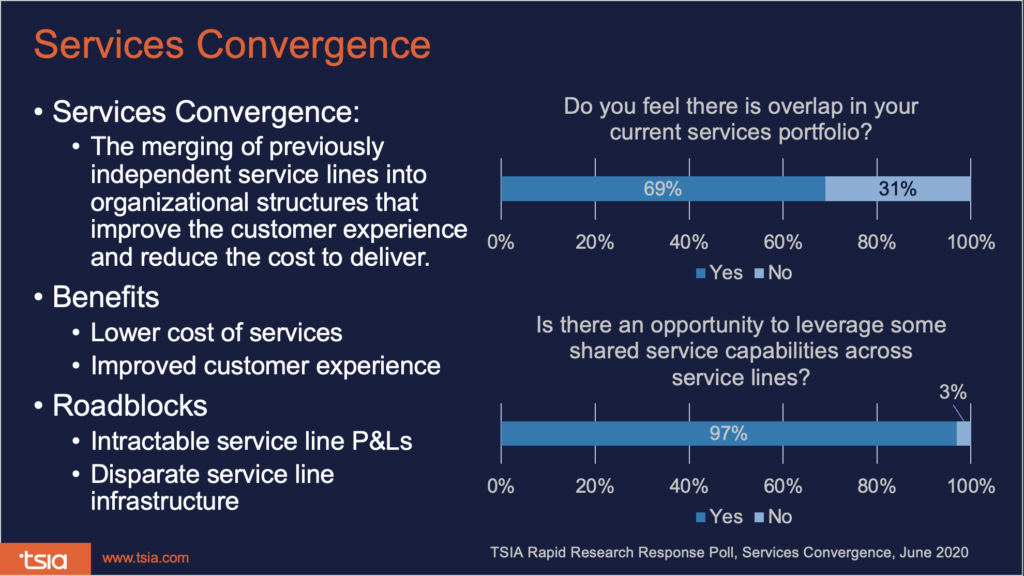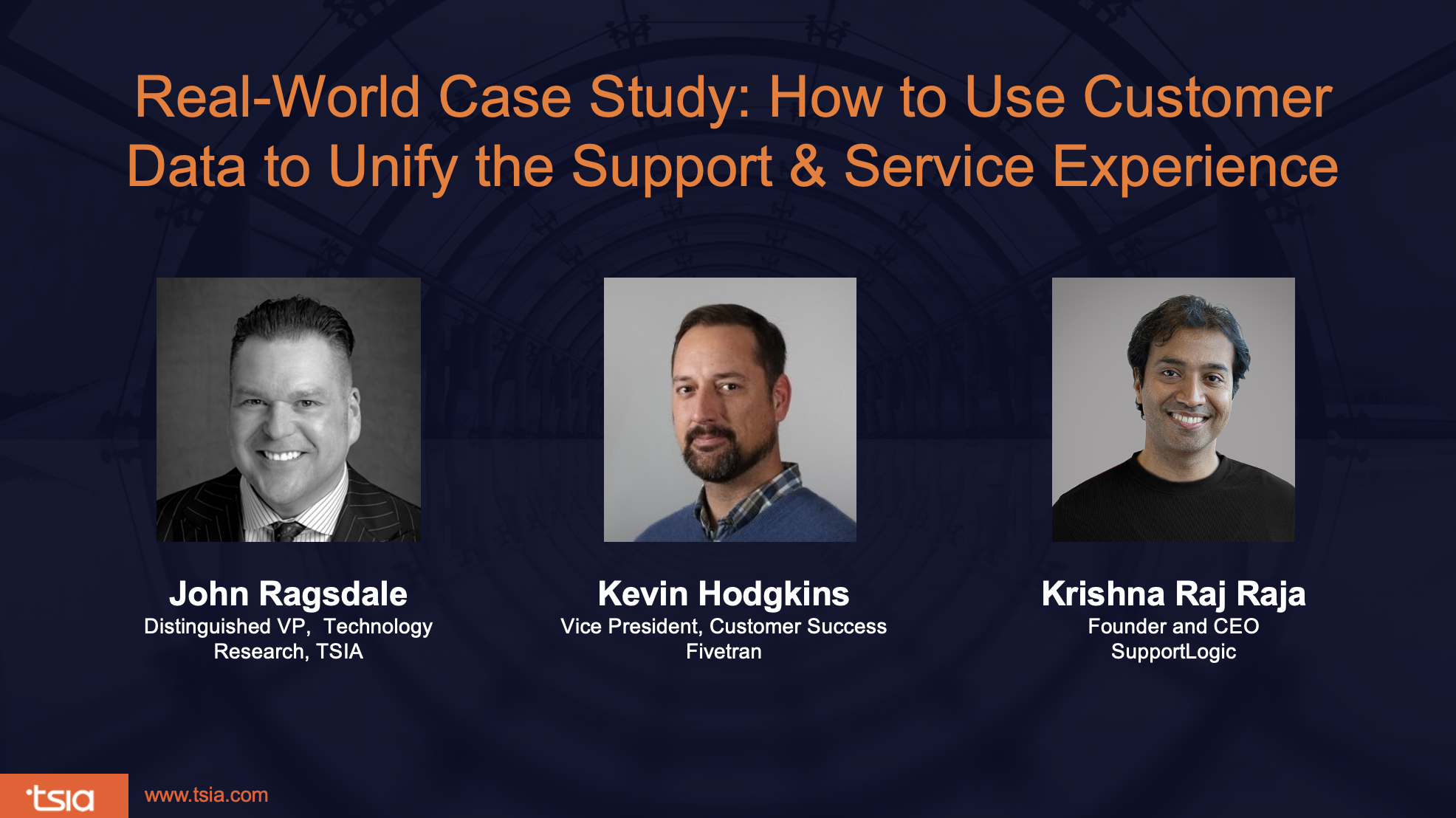
Mar 30, 2021
5 Ways Fivetran Uses Customer Data to Unify the Support and Service Experience
Churn ReductionCustomer SuccessFivetranTSIA
SupportLogic recently co-hosted a webinar with John Ragsdale at TSIA on How to Unify the Support and Service Experience with Customer Data. Joining John was SupportLogic customer, Kevin Hodgkins, VP Customer Success at Fivetran, and Krishna Raj Raja, Founder and CEO of SupportLogic. The discussion focused on the theme of ‘convergence’ among support and success teams and how to use customer data and AI-driven predictions to improve the customer experience across the post-sale journey.

Fivetran automates data integration from many source systems with pre-built data connectors and partners with software companies like SupportLogic to enable richer data-powered features. Fivetran is on a mission to deliver great experiences for their customers at scale while enabling its own organization to drive business value from data. In ‘hyper scale-up’ mode Fivetran has doubled its customers every year which has challenged the organization, especially during COVID-19.
Here are five takeaways from our discussion:
1. Acting on customer signals from support data can reduce churn by 25%
New KPIs are invaluable to measure the impact of modern customer success organizations. Fivetran has been on a journey to evolve the way they measure the impact of the customer success organization. As Kevin shares: “The most important business outcome for us is increased revenue. We are a company selling products to others and our revenue is very important. What we’re most proud of with our partnership with SupportLogic is that we’ve been able to drive a 25% reduction in customer churn. This metric enables us to tie revenue very directly to our customer success organization.”

But that didn’t happen overnight. Fivetran first introduced a new indicator: customer sentiment score. “It goes beyond this operational thing we look at, it’s real-time and we can judge how our customers are feeling about us right now,” Kevin shares. “We can use that information in SupportLogic to determine how to engage with them. We’re very happy that we have a high customer sentiment score.”
Second, Kevin shared that “when customer sentiment score is high, it directly drives improvements in the more traditional metrics around service. Fivetran has been able to increase CSAT from 90-95% over the last 6 months. We’re very proud of that! We’ve worked very hard, and we know service can often be a thankless vocation. To be able to see these results is very positive.” Finally, when you have strong customer satisfaction, customers are more willing to advocate for you. Fivetran has also seen a significant increase in their Net Promoter Score (NPS).
Most companies approach these metrics backwards today. There’s an understandable desire to simplify the Voice of the Customer (VoC) measurement with one or two metrics like CSAT and NPS. But the truth is that they’re both ‘after the fact’ metrics and are hard to change on their own. What Fivetran has done is flip the process to focus first on an actionable metric (customer sentiment score) used to actively improve the customer experience. The improved customer experience results in measurable CSAT and NPS improvements.
2. Two-thirds of enterprises see an opportunity to converge their success and support organizations
What convergence means is breaking down silos between lines of business and the support function to improve the end-to-end customer experience and lower the cost of service delivery. This is a topic near and dear to the heart of TSIA and its member companies. John shared that while in the past most companies structured these teams as separate functions, there’s a willingness to consider converging them today. From a survey last year, 69% of companies felt there’s an overlap in their current services portfolio; 97% felt there’s an opportunity to leverage some shared service capabilities, resources, and skills across service lines.
There are significant operational challenges to converging functions, especially for large, established enterprises that have intractable service lines. These business units typically each have their own budgets, P&L, and technology infrastructure. These barriers make it difficult to break down silos and share resources across teams.

Fivetran has converged support and success. Kevin shared that they did not have a customer success team previously and he has built a converged CS function from scratch to better serve customers. The principles behind how they did it, according to Kevin:
- These functions are all different facets of servicing the customer. Bringing these groups together to reinforce what each group does provides a better experience for customers.
- They focus on customer insights and a “modern support strategy” which is dependent on customer data to make decisions. According to Kevin, “A converged CS strategy honestly can’t be done without good data. Great employee experiences lead to great customer experiences when they have the right data and can make the right decisions at the right times.”
- Their support function is evolving to become more proactive and focuses on operationalizing processes and utilizing tools to better serve customers when and where they need it.
- One of the benefits of a converged org is that it becomes less about finger pointing and instead collaborating to solve problems. Having them under one executive helps to do this.
3. Analytics are insufficient; you need AI-assisted workflows
While customer data and insights are critical to unifying Support and Success functions, the real value is unlocked when an organization can use the customer insights to trigger actions that improve the customer experience in real time and enable decreased escalations and churn.
Krishna shared that “one of the most delightful experiences the customers of SupportLogic receive is when they express negative sentiment, they can get a call just 10 minutes later from the customer success manager to intercede and improve their situation. This completely transforms the customer experience, which is why many of our customers see a significant jump in CSAT and NPS scores, because you’re attacking the problem while it’s happening vs a survey when it’s too late and the customer has already given up on you.”
When an organization is aligned around a single view of each customer, it can be more proactive about addressing their needs. Kevin shared that at Fivetran, “Our organziation is focused on using data to improve customer experience. One of the first things we did with data was to create a health score. We also created a strategic score. These indicators are fed into the support organization and signal when customers need special handling. We want to provide our customers with all the special handling they need.”
Krishna shared SupportLogic’s plans to invest in workflows that directly help support engineers and customer success managers better serve customers. “We’re becoming an angel on the shoulder of support engineers, gently nudging and guiding them on what they need to do in real-time. We believe this will fundamentally change every important metric for the organization, whether it’s CSAT, NPS or net retention rate. It all starts with this fundamental interaction point that your support engineers have with your customers.”
John said, “Companies invest a lot of time and money in quality management programs, which involve pulling an agent in and saying ‘two weeks ago you had this problem and you could have handled it better.’ But it doesn’t really help two weeks after the fact so I love the idea of proactive coaching.”
4. Unlock customer signals from support data to showcase the value of the Support organization
Historically, support organizations haven’t had a lot of clout within most enterprises. But our panel shared that data is becoming an equalizer to give visibility to the value of support.
According to Kevin, Fivetran Support communicates with customers more than every other group in the company combined. He shared that they handle over 15k support interactions per month. Every single one is a tremendous opportunity to both bring new insight to the company and also create a great customer experience.
Krishna shared that one of the hidden values of the Support organization is that they unlock data for all the functions in the company. “Support has data for everyone. They have data to help the product and data to help sales. So bringing these data points together is critical. It’s not just metadata, which is watered down. It’s customer sentiment data extracted from unstructured data. And when you put this data together customer conversations and team collaboration become a lot more natural.”

SupportLogic was founded based on Krishna’s personal experience in support. He shared that “today, we see customer conversations going beyond ‘break fix’ issues. While you often start with a technical issue, you quickly become the trusted advisor to the customer. Customers would ask ‘what is the best solution for X?’ And in the process. You help the customer adopt the product even more. And if Support is run with a focus on what is the customer trying to do and how do we help them along this journey vs fixing a problem, then you become a lot more valuable to the customer.”
5. Support now plays a key role in product adoption and expansion revenue
Product-led growth (PLG) companies are prevalent in the market today e.g. Zoom and Snowflake – their product growth strategies are based on using the product to grow the customer base. But the challenge is that their customers have very high expectations. When those customers get access to the product first, and if their experience is poor and they don’t resolve issues in that initial onboarding, then their adoption will stall. And those customers may churn without you knowing the lost potential of the account.
Krishna shared that “a classic PLG example is Amazon Web Services or Google Cloud – there may be an individual developer who pays $50/mo for an instance. If they find the adoption process easy, if they get their questions answered and they have a great experience, it could grow into a multi-million dollar account. But if the customer has a poor experience then the customer will walk away and you may not even realize the lost potential. Support now plays a very important role in the revenue stream for those customers in a product-led growth model.”
Kevin shared that for Fivetran, “we want everyone on our team to live outside of the transaction. Serve the customer and don’t worry about just closing the deal or just closing the ticket. Fivetran is a product-led growth company and it’s important to think about how these things fit into the overall customer journey, because if you do the right things, your customers will grow with you.”
How to learn more:
If you weren’t able to attend the live webinar, you can see it on demand here. We’d love to hear what you think!
As you think about your plans for investing in your support organizational capabilities in 2021, let us know how we can help you by providing consultative guidance based on the learning from our customers.
Don’t miss out
Want the latest B2B Support, AI and ML blogs delivered straight to your inbox?





